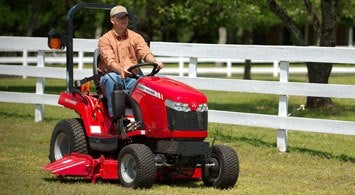
In the first installment of this series, we covered the importance of selecting and working with a dealer and some of the advantages subcompact utility tractors (SCUTs) and compact utility tractors (CUTs) offer. In installment two we dug into tasks you might want to tackle and the implements to accomplish them. We also talked about ergonomics and resale, as well as some basic buying advice. This week we’ll wrap everything up with special considerations to be aware of, options to consider, the test drive, things to avoid and the final purchase.
Special Considerations
Slopes are important to take into consideration. Being longtime tractor users, and frequenting MyTractorForum.com since its inception, we’ve see over and again examples where a first-time purchaser buys a machine inadequate for their needs and then posts looking for Band-Aids to make the tractor perform more safely. Adding wheel weights, loading the tires with fluids and playing with tire pressure can all have positive effects, but those additions may shorten the life of box store machines and will never transform an incorrect tractor selection into a right one.
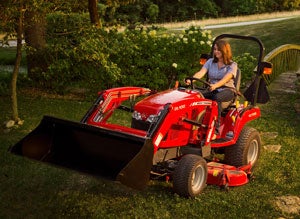
Here again you should lean on your dealer for its experience. Your dealer should be familiar with your particular situation, either by knowing your property or visiting it, and using that expertise to make a recommendation.
If you’ve been surfing websites and come across posts suggesting that measuring the slope is a way of determining what is safe and what is not, don’t buy into it. Though there are devices such as inclinometers that can quantify the degree of slope, there is no tractor manufacturer who will come out and state what degree of slope will be safe. Remember, situations change and turf that is dry one day can be wet and slippery the next. A surprise rut can ruin anyone’s day. Shiny side up should be your motto and purchasing the right machine for your needs is the best path towards that end.
Options To Consider
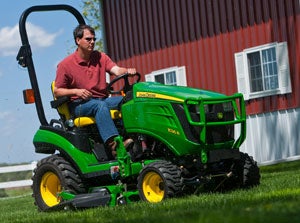
Generally there are three styles of tires offered for SCUT/CUT tractors with a less common fourth style we’ll touch on. The most common tire is a Turf tread, also known as R3. This is a good all-around tire that has the least impact on your turf and lawn. Turf tires are good when dry but don’t fare so well in the mud. A second type of tire is an Ag tread, also known as R1. As its name implies, this is the most aggressive tire tread. Ag tires excel in muddy conditions but have the most impact on your turf. If you’re not fanatic about your lawn, you might get away with mowing with Ag tires, but few would recommend doing so. A third type of tire is a compromise. Known as Industrial tread tires, or R4, they come with a tread design that is less aggressive than Ag tires and easier on your turf but still able to handle muddy conditions. We don’t recommend tight turns on a pristine lawn with a tractor outfitted with Industrial tires, but if you can arrange generous mulch beds around trees etc, this compromise might be the right choice for you. The last style which is less common carries the trade name Galaxy turf. This is a special extra wide, low impact tire designed for golf courses and situations where ground impact must be kept to a minimum, as well as conditions where a high degree of flotation is necessary. Talk to your dealer about which style tire is right for you.
Lighting is another area where your needs might warrant optional equipment. Most SCUT/CUT tractors come with decent lighting, but if you intend to do a lot of work when the sun goes down, optional packages that mount additional lights on the tractor fenders and/or ROPS are available. Just be mindful that adding lighting will increase the demand on your tractor’s alternator. Talk to your dealer; he may recommend an optional, larger alternator.
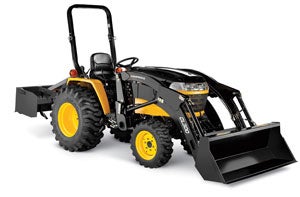
If you intend to get a loader with your SCUT/CUT tractor – and why wouldn’t you? – make sure a ballast box is included. Tractors of today are much lighter than tractors of old. Lighter weights are the result of competitive cost cutting, but weight aids in traction as well as counterbalances axle load, which are all good things. A ballast box attaches easily to your three-point hitch (3PH) and can be filled with everything from cinder blocks to gravel to concrete. A nice touch we’ve seen is placing PVC pipes in the ballast box before filling the cavity with concrete, creating storage places for rakes and other tools. Use your imagination.
A quick hitch is another optional accessory that reduces the struggle of attaching a 3PH implement or attachment. 3PH attachments are often heavy and if you don’t back the tractor in exactly square, there is invariable some degree of effort and fuss to get everything lined up. With a quick hitch, you just back in and lift up the 3PH. Talk to your dealer, though, as there are several styles available with some requiring implements with certain spacing and additional pins and bushings.
An extended warranty is another option to consider. We personally don’t purchase them, feeling that if the tractor is a quality machine, an extended warranty isn’t needed. You may feel differently. If so, have that discussion with your dealer.
Test Drive
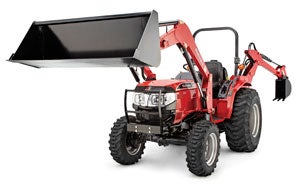
So you’ve found a dealer you’re comfortable with, spent time talking about your needs (now and into the future), and settled on one or more machines that could do the job. What should be next? It’s time to test drive the tractor(s). We talked to Cleo Franklin, vice president of Mahindra USA, who is a firm believer in customer tractor demonstrations and test driving during the buy decision process.
“It helps demonstrate to the customer the tractor’s capability, performance, ease of use and versatility but more so validates back to the customer they are purchasing the right tractor for their needs and sometimes even more so for needs they did not anticipate or expect. Simply put – tractor test drives can be a win/win for the dealer and customer,” says Franklin.
We had a similar conversation with Roger Harrod, a Massey Ferguson dealer in Roopville, Ga. who sells a number of compact tractors.
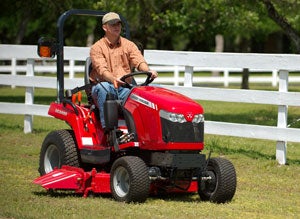
“I strongly recommend customers test drive the tractors they are considering buying. A consumer shouldn’t make that investment without getting a feel for its maneuverability, ease of operation, comfort and power,” says Harrod. He adds that before purchasing a new tractor or beginning a test drive, customers should ask their dealer for a full explanation of the tractor and the controls on the model they are interested in purchasing.
“Ask the dealer to review tractor safety features prior to the demo drive. After you are comfortable with operating the machine, it is perfectly acceptable to request that you explore the tractor on your own,” says Harrod. “Most people enjoy privacy while test driving, although we are always on hand to provide tips on how best to operate the tractor.”
We at Tractor.com agree with both manufacturers’ advice, but like to take it a step further. Now that you’re serious – and indicate that to the dealer – ask to have the machine(s) demoed on your property. Sometimes this might not be possible; you may live in a rural area that is far enough away from the dealer that it becomes impractical – but if it is possible we highly recommend doing so. There is nothing like getting a feel for how a machine handles on the property it is going to be used on.
Don’ts
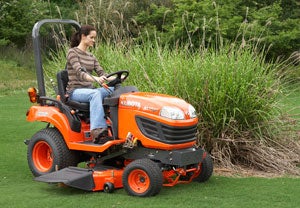
We asked Paul Williams from Kubota for purchasing advice for the first time SCUT/CUT buyer and he gave us a list of don’ts beginning with don’t ignore special financing offers.
“While you may feel overwhelmed by the thought of purchasing a tractor, you can put your mind at ease by working with your dealer to tailor a finance program that specifically meets your requirements. Choosing the best package with the right financing now could save you money in the long run,” says Williams. “Don’t focus solely on price. While an important factor in making your purchasing decision, price shouldn’t be your only factor. Focus on how the tractor will help you realize time efficiencies and maximize productivity for years to come. Remember, quality is long remembered when price is forgotten. When it comes to equipment, there is no substitute for quality and buying from a company who has earned and is respected for a quality reputation.
Purchase
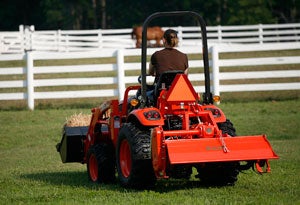
So you’ve honed in on the right machine, figured out what attachments you will need, haggled over the price, and come to a deal. Now the tough part comes: waiting for the tractor to be delivered. Generally this isn’t long, but even if the tractor is in stock, the dealer will need to do required prep and install the implements and options you have chosen. While this is going on, reading the owner’s manual makes for a good way to whittle away at the time. And that is our last recommendation; that you read the owner’s manual from cover to cover. The dealer will go over the tractor functions at time of delivery, but that is no substitute for reading the manual and becoming familiar with manufacturer recommended safe operation and the maintenance schedule you will need to adhere to. After that, go on out and get your new tractor dirty. Don’t be surprised if you find yourself washing and waxing it afterwards.
Related Reading
How To Shop For A Tractor: Part I
How To Shop For A Tractor: Part II
2013 National Farm Machinery Show Report
35th Annual Antique Engine & Tractor Show Report
 Your Privacy Choices
Your Privacy Choices